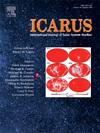角动量消耗:抑制嵌入的星子
IF 3
2区 物理与天体物理
Q2 ASTRONOMY & ASTROPHYSICS
引用次数: 0
摘要
年轻的和正在形成的星子受到原恒星盘中粒子的撞击。利用陨石坑尺度定律,我们整合了倾斜撞击的喷出物分布。对于10到65米/秒的撞击,预计与盘风有关的撞击,我们估计了施加在小行星上的侵蚀速率和扭矩。我们发现Dobrovolskis和Burns(1984)提出的小行星角动量流失机制可以在盘状风的低速状态下运行。我们发现角动量通过碰撞流失在重力聚焦状态下发生。角动量传递在风速较大、弹丸密度大于体星子密度、星子足够弱使弹坑处于重力状态时最为有效。我们发现,在这些特定条件下,由于卵石云内的撞击而产生的角动量流失可能会促进单个星子的坍缩。本文章由计算机程序翻译,如有差异,请以英文原文为准。
Angular momentum drain: Despinning embedded planetesimals
Young and forming planetesimals experience impacts from particles present in a protostellar disk. Using crater scaling laws, we integrate ejecta distributions for oblique impacts. For impacts at 10 to 65 m/s, expected for impacts associated with a disk wind, we estimate the erosion rate and torque exerted on the planetesimal. We find that the mechanism for angular momentum drain proposed by Dobrovolskis and Burns (1984) for asteroids could operate in the low velocity regime of a disk wind. We find that angular momentum drain via impacts operates in the gravitational focusing regime. The angular momentum transfer is most effective when the wind speed is high, the projectile density is high compared to the bulk planetesimal density, and the planetesimal is sufficiently weak that cratering is in the gravity regime. We find that angular momentum drain due to impacts within a pebble cloud may, in those specific conditions, facilitate collapse of single planetesimals.
求助全文
通过发布文献求助,成功后即可免费获取论文全文。
去求助
来源期刊

Icarus
地学天文-天文与天体物理
CiteScore
6.30
自引率
18.80%
发文量
356
审稿时长
2-4 weeks
期刊介绍:
Icarus is devoted to the publication of original contributions in the field of Solar System studies. Manuscripts reporting the results of new research - observational, experimental, or theoretical - concerning the astronomy, geology, meteorology, physics, chemistry, biology, and other scientific aspects of our Solar System or extrasolar systems are welcome. The journal generally does not publish papers devoted exclusively to the Sun, the Earth, celestial mechanics, meteoritics, or astrophysics. Icarus does not publish papers that provide "improved" versions of Bode''s law, or other numerical relations, without a sound physical basis. Icarus does not publish meeting announcements or general notices. Reviews, historical papers, and manuscripts describing spacecraft instrumentation may be considered, but only with prior approval of the editor. An entire issue of the journal is occasionally devoted to a single subject, usually arising from a conference on the same topic. The language of publication is English. American or British usage is accepted, but not a mixture of these.
 求助内容:
求助内容: 应助结果提醒方式:
应助结果提醒方式:


